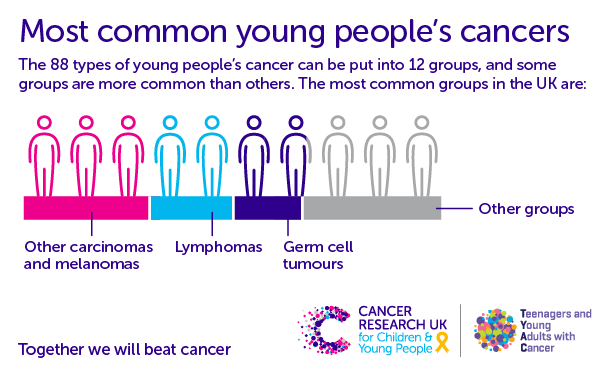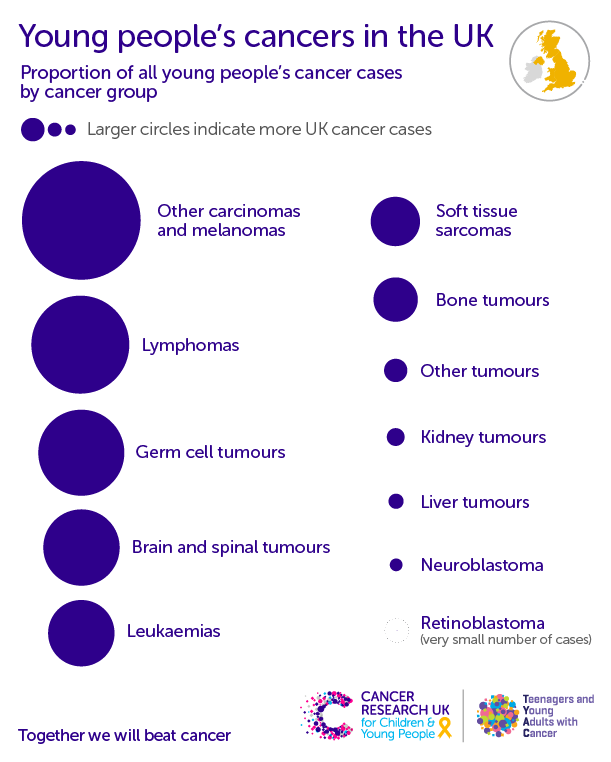Cancer in young people accounts for less than 1% of all new cancer cases in the UK (2017-2019).[1-4]
51% of young people's cancer cases in the UK are in females, and 49% are in males.
Young people's cancer incidence rates (European age-standardised  ) are significantly lower than the UK average in Wales and are similar to the UK average in all other UK constituent countries.
) are significantly lower than the UK average in Wales and are similar to the UK average in all other UK constituent countries.
Young People's Cancers (C00-C97, D32-D33, D35.2-D35.4, D42-D43, D44.3-D44.5), Average Number of New Cases Per Year, Crude and European Age-Standardised (AS) Incidence Rates per 100,000 Population, Ages 15-24, UK, 2017-2019
| England | Scotland | Wales | Northern Ireland | UK | ||
|---|---|---|---|---|---|---|
| Female | Cases | 1,008 | 97 | 48 | 41 | 1,195 |
| Crude Rate | 31.4 | 30.8 | 26.6 | 37.2 | 31.3 | |
| AS Rate | 31.2 | 30.4 | 26.5 | 37.5 | 31.1 | |
| AS Rate - 95% LCI | 30.1 | 26.9 | 22.2 | 30.9 | 30.1 | |
| AS Rate - 95% UCI | 32.3 | 33.9 | 30.8 | 44.1 | 32.1 | |
| Male | Cases | 977 | 89 | 43 | 34 | 1,143 |
| Crude Rate | 28.8 | 27.6 | 21.5 | 28.9 | 28.3 | |
| AS Rate | 28.6 | 27.6 | 21.4 | 29.3 | 28.2 | |
| AS Rate - 95% LCI | 27.6 | 24.3 | 17.7 | 23.6 | 27.2 | |
| AS Rate - 95% UCI | 29.7 | 30.9 | 25.2 | 34.9 | 29.1 | |
| Persons | Cases | 1,985 | 186 | 91 | 76 | 2,338 |
| Crude Rate | 30.0 | 29.2 | 23.9 | 32.9 | 29.7 | |
| AS Rate | 29.9 | 29.0 | 23.9 | 33.2 | 29.6 | |
| AS Rate - 95% LCI | 29.1 | 26.6 | 21.0 | 28.9 | 28.9 | |
| AS Rate - 95% UCI | 30.6 | 31.4 | 26.7 | 37.6 | 30.3 | |

References
-
England data were provided by the National Cancer Registration and Analysis Service (NCRAS), part of the National Disease Registration Service (NDRS) in NHS England, on request through the Office for Data Release, January 2023. Similar data can be found here: https://www.cancerdata.nhs.uk/
-
Northern Ireland data were provided by the Northern Ireland Cancer Registry (NICR) on request, October 2021. Similar data can be found here:http://www.qub.ac.uk/research-centres/nicr/.
-
Welsh data were published by the Welsh Cancer Intelligence and Surveillance Unit (WCISU), Health Intelligence Division, Public Health Wales https://phw.nhs.wales/services-and-teams/welsh-cancer-intelligence-and-surveillance-unit-wcisu/cancer-reporting-tool-official-statistics/ June 2022.
-
Scotland data were provided by the Scottish Cancer Registry, Public Health Scotland (PHS) on request, May 2021. Similar data can be found here: https://publichealthscotland.scot/publications/show-all-releases?id=20468
About this data
Data is for UK, 2017-2019, ICD-10 C00-C97, D32-D33, D35.2-D35.4, D42-D43, D44.3-D44.5.
Young peoples' cancers includes all malignant tumours (ICD-10 codes: C00-C97), and all non-malignant brain, other central nervous system and intracranial tumours (ICD-10 codes: D32-D33, D35.2-D35.4, D42-D43 and D44.3-D44.5).






